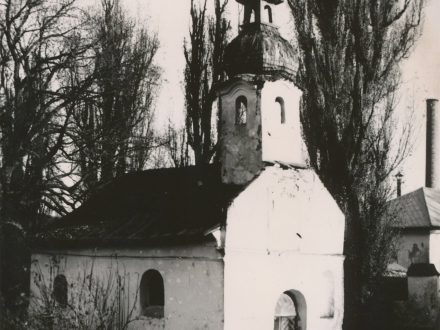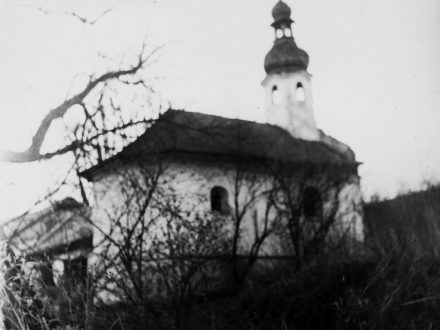Chapel
With the establishment of a new mansion, its noble inhabitants began to feel the need for their own sanctuary. Vatětice belonged to the parish under the nearby Mouřenec with the local church of St. Morice and after 1684 the owners of Vatětice gained patronage right over this church (formerly belonged to the town of Sušice). The small premises of this tabernacle and the large number of small farms in the area motivated individual nobility to set up private chapels directly at their chateau mansions. Their foundation started in the second half of the 17th century – St. Antonín Paduánský Chapel was built in Kundratice, in 1689 Marie Anna Říčanská of Říčany reconstructed the chateau chapel of St. Valentin in Palvínov, built in 1682, around 1714, the count Gottfried Daniel Wunschwitzhe founded the Chapel of St. John of Nepomuk at his castle in Dolejší Krušec, in 1746 a chapel at the castle in Dolní Těšov was founded. Under the same conditions, a chapel was established in Vatětice, despite the fact that the Vatětice owners, as holders of patronage rights, had a place of honor in the Church of the Mourners, where they certainly had their patronage benches. The site was chosen in the vicinity of the mansion between the main driveway from Palvínov and the pond, which clearly indicates the builder’s intention – to establish a private sanctuary for the residents of the castle. The oriented construction of a rectangular ground plan was covered with a saddle roof with a ridge perpendicular to the western facade, over which a tower with an onion dome and a quadrilateral lantern was built. The sides were broken by a pair of windows with a semicircular top. The main entrance from the west was also semicircular, the sides beside it were adorned with two semi-cylindrical niches topped with a hurry. The same niche was still above the entrance. The interior of the chapel had a presbytery vaulted by a board. In the side niches were placed rococo statues of st. Tadeáš a sv. Dominik. The altar bore the rococo painting Capturing from the Cross, over which were united coats of arms (one of them belonged to the Boryň’s family of ‘Lhota). German natives recalled even more unspecified paintings that were punctured, which, along with stone balls embedded in an iron frame, explained somewhat romantically as a reminder of the tumultuous times of the Thirty Years’ War.
- Kaple od západu
- Indikační skice stabilního katastru
- Kaple od severu
Chapel
With the establishment of a new mansion, its noble inhabitants began to feel the need for their own sanctuary. Vatětice belonged to the parish under the nearby Mouřenec with the local church of St. Morice and after 1684 the owners of Vatětice gained patronage right over this church (formerly belonged to the town of Sušice). The small premises of this tabernacle and the large number of small farms in the area motivated individual nobility to set up private chapels directly at their chateau mansions. Their foundation started in the second half of the 17th century – St. Antonín Paduánský Chapel was built in Kundratice, in 1689 Marie Anna Říčanská of Říčany reconstructed the chateau chapel of St. Valentin in Palvínov, built in 1682, around 1714, the count Gottfried Daniel Wunschwitzhe founded the Chapel of St. John of Nepomuk at his castle in Dolejší Krušec, in 1746 a chapel at the castle in Dolní Těšov was founded. Under the same conditions, a chapel was established in Vatětice, despite the fact that the Vatětice owners, as holders of patronage rights, had a place of honor in the Church of the Mourners, where they certainly had their patronage benches. The site was chosen in the vicinity of the mansion between the main driveway from Palvínov and the pond, which clearly indicates the builder’s intention – to establish a private sanctuary for the residents of the castle. The oriented construction of a rectangular ground plan was covered with a saddle roof with a ridge perpendicular to the western facade, over which a tower with an onion dome and a quadrilateral lantern was built. The sides were broken by a pair of windows with a semicircular top. The main entrance from the west was also semicircular, the sides beside it were adorned with two semi-cylindrical niches topped with a hurry. The same niche was still above the entrance. The interior of the chapel had a presbytery vaulted by a board. In the side niches were placed rococo statues of st. Tadeáš a sv. Dominik. The altar bore the rococo painting Capturing from the Cross, over which were united coats of arms (one of them belonged to the Boryň’s family of ‘Lhota). German natives recalled even more unspecified paintings that were punctured, which, along with stone balls embedded in an iron frame, explained somewhat romantically as a reminder of the tumultuous times of the Thirty Years’ War.
- Kaple od severu
- Kaple od západu
- Indikační skice stabilního katastru




